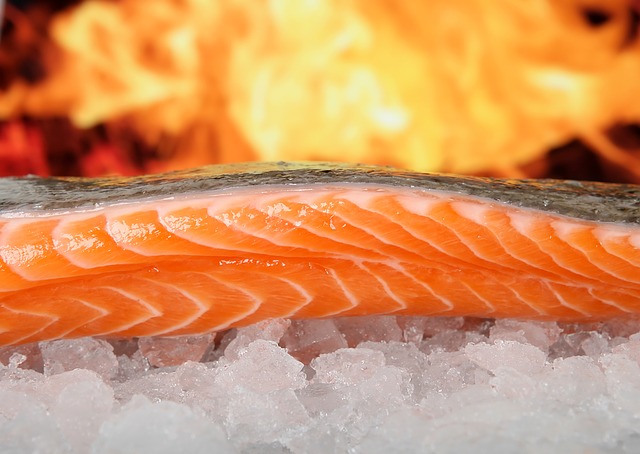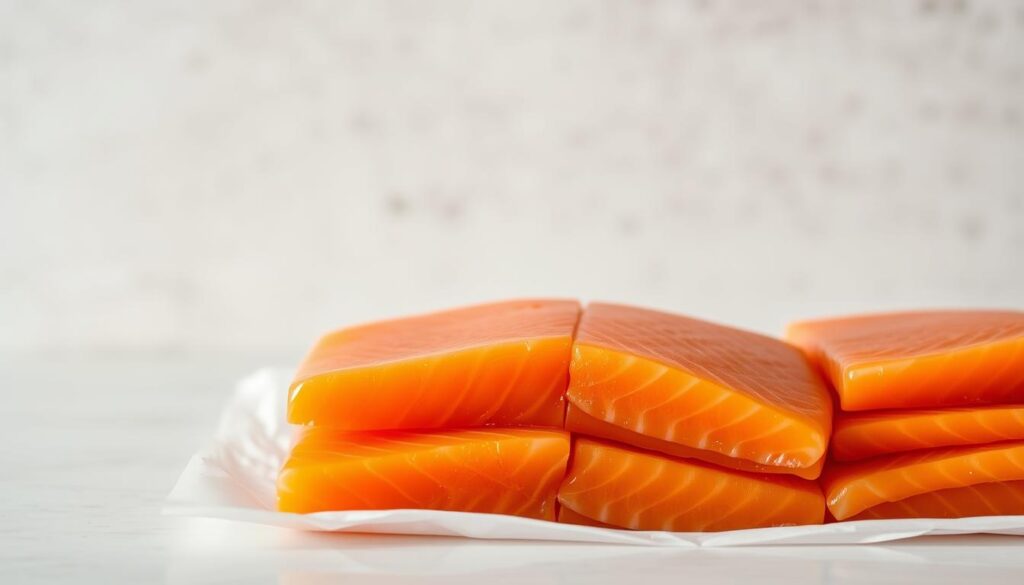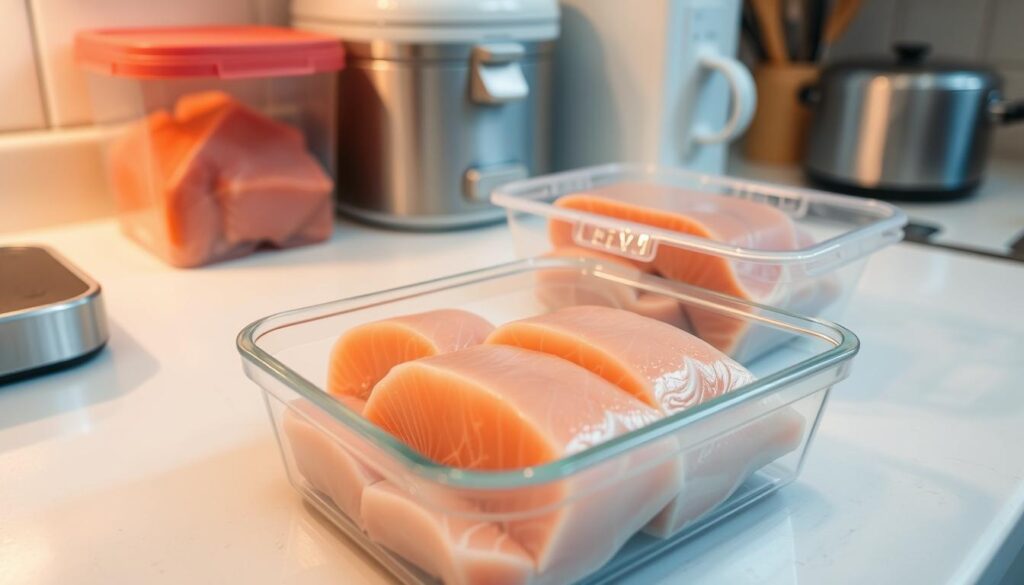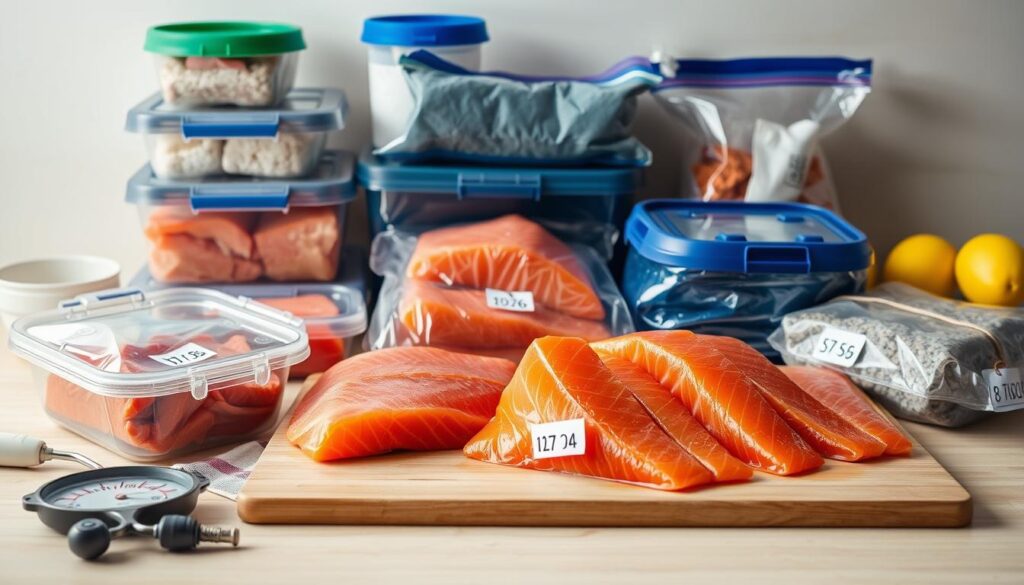Ever wondered if it’s safe to refreeze salmon after thawing it? Salmon is pricey and perishable, so handling it right is key. But is refreezing risky, or can it be done safely? This article answers can you refreeze salmon? and shares tips for safe and tasty meals.

Key Takeaways
- Refreezing salmon depends on how it was stored and handled before thawing.
- Following freezing salmon safely steps reduces bacterial growth risks.
- Thawing methods impact whether refreezing is an option.
- Proper packaging extends salmon’s shelf life even after refreezing.
- Ignoring storage rules can lead to texture loss and safety issues.
The Truth About Refreezing Salmon
Refreezing fish safely is possible if you follow the right refreezing guidelines. Knowing the best conditions is essential to avoid risks. Here’s what you need to know.
When Refreezing Is Safe
You can safely refreeze salmon if it thawed in the fridge. It should stay at or below 40°F (4°C) for no more than two days. Here’s how:
- Thaw fish in the fridge and use within 1–2 days before refreezing.
- Repackage: Store in airtight containers to prevent moisture loss and freezer burn.
When Refreezing Should Be Avoided
Never refreeze salmon if it was left out at room temperature for more than two hours. Avoid these scenarios:
- Salmon thawed on the counter or in warm water.
- Fish that’s been cooked, then cooled and refrozen.
- Portions left in the “danger zone” (40°F–140°F) for over two hours.
The Science Behind Freezing Fish
Freezing stops bacterial growth, but thawing lets microbes multiply. Each freeze-thaw cycle creates larger ice crystals. These damage cell walls, reducing texture and safety. Here’s how it breaks down:
| Factor | First Freeze | Second Freeze |
|---|---|---|
| Ice Crystal Size | Small, minimal damage | Larger, cell breakdown |
| Bacterial Growth | Paused | Rapid if thawed improperly |
| Texture | Firm and moist | Dry or mushy |
Follow USDA recommendations to minimize risks and maintain quality.
Understanding the Risks of Improper Fish Storage
Storing salmon wrong or refreezing seafood without care can be dangerous. It can harm both safety and quality. Here’s why:
Bacterial Growth Concerns
Warm temperatures make pathogens grow fast. Salmon in the “danger zone” (40°F–140°F) for too long gets infected. To stay safe, follow these tips:
- Never leave thawing salmon at room temperature longer than 2 hours
- Refrigerate leftovers within 2 hours of cooking
Texture and Quality Changes
Freezing salmon over and over damages it. Ice crystals hurt cell walls, leading to:
- Dry, rubbery texture
- Off-flavors from oxidation
- Unappealing translucent patches
Nutritional Impact of Multiple Freeze Cycles
Freezing salmon many times can reduce nutrients. Here’s how it affects important nutrients:
| Nutrient | Impact |
|---|---|
| Omega-3 Fatty Acids | Up to 20% degradation after 3 freeze-thaw cycles |
| Vitamin B12 | Loss of up to 15% bioavailability |
| Moisture Retention | Cell rupture causes sogginess upon cooking |
Refrozen salmon might taste bad and have fewer health benefits. Always store it right to avoid these problems.
The Proper Way to Thaw Salmon Before Cooking
Proper thawing is key to keeping salmon safe for thawing and refreezing fish. It’s important to use methods that prevent bacterial growth. Here’s how to thaw salmon the right way:
“Never thaw seafood at room temperature—it’s a breeding ground for bacteria,” warns the USDA.
- Refrigerator Thawing: Put frozen salmon in a sealed container on the bottom shelf. It takes 8-12 hours for a 1.5 lb fillet. This is the safest method for best way to store salmon afterward.
- Cold Water Thawing: Put it in a waterproof bag in cold water (70°F or cooler). Change the water every 30 minutes. It takes 30-60 minutes per pound.
- Microwave Thawing: Use the defrost setting. Cook it right away—do not refreeze microwaved fish.
| Method | Steps | Time | Notes |
|---|---|---|---|
| Refrigerator | Container on bottom shelf | 8–12 hrs | Safest for refreezing |
| Cold Water | Change water every 30 mins | 30–60 mins/lb | Wrap tightly first |
| Microwave | Defrost setting | 5–10 mins/lb | Do not refreeze |
Don’t leave salmon out at room temperature or thaw it in hot water. After thawing, use it within 2 days or refreeze within 24 hours. Always check for slime or off smells before cooking.
Can You Refreeze Salmon That Was Previously Frozen?
When deciding to refreeze salmon, follow refreezing guidelines for safety. The fish’s state—raw or cooked—and how it was handled after thawing are key.

Raw vs. Cooked Salmon Refreezing Guidelines
- Raw salmon: Refreeze only if it stayed at 40°F or below after thawing. Use it within 2 days to prevent bacterial growth.
- Cooked salmon: It’s safe to refreeze if cooled quickly. For best quality, store it in an airtight container within 3 hours of cooking.
Time and Temperature Considerations
Salmon’s temperature history is critical for safety. Here’s what to do:
- Check thawing time: Never let salmon sit at room temperature for more than 2 hours (1 hour if it’s over 90°F).
- Freeze promptly: After thawing, refreeze raw salmon within 2 days. Cooked salmon has a 3-day window.
“The USDA advises against refreezing thawed seafood unless it was first cooked to 145°F to kill pathogens.”
Always put quality and safety first. If in doubt, it’s better to discard than risk foodborne illness.
Best Practices for Freezing Salmon the First Time
Freezing salmon safely begins with the right preparation. This helps keep the fish fresh and flavorful. Follow these steps to ensure quality and safety.
Proper Packaging Techniques
Keep salmon away from air with these tips:
- Pat fish dry with paper towels before wrapping.
- Wrap tightly in plastic wrap, then seal in a heavy-duty freezer bag or airtight container.
- Try vacuum-sealed bags to remove all air, reducing oxidation.
Freezing salmon in layers prevents ice crystal formation and freezer burn.
Portion Control for Easier Defrosting
Divide salmon into portions based on family size or recipe needs:
- Use 8-12 ounce portions for standard meals.
- Freeze fillets or steaks in labeled bags to avoid over-thawing.
- Separate skin-on and skin-off pieces if desired.
Labeling and Rotation Systems
Track your stock with clear labels and rotation strategies:
- Write the freeze date, weight, and thaw status on each package.
- Store oldest portions at the front of the freezer for first-in, first out use.
- Check expiration every three months for peak quality.
Labeling details like freeze dates ensures you always use the freshest stock first.
These steps create a system for long-term salmon preservation.
How to Tell If Salmon Is Stil Safe to Refreeze
Deciding to refreeze salmon needs careful checking. Follow these salmon storage tips to see if it’s fresh and safe before freezing again.

First, track how long it’s thawed. Throw away fish that’s been at room temperature for over two hours. For fish thawed in the fridge, use it within two days before thinking about can you refreeze salmon? If it’s been longer, it’s best to discard it.
Look for these signs:
- Appearance: Don’t use salmon that’s grayish, too dry, or sticky.
- Smell: Bad smells like sour or ammonia mean it’s not good. Fresh salmon smells slightly salty.
- Texture: Press it gently. Safe salmon feels firm and bounces back. If it feels mushy or rubbery, it’s not safe.
Avoid refreezing if you see:
- Foul smells that don’t go away after rinsing
- Slime or mold
- Visible fat and muscle separation
“When in doubt, throw it out. No test can replace common sense,” advises the USDA Food Safety and Inspection Service.
Even if salmon looks okay, bacteria might be hiding. Always choose safety over doubt. Never refreeze fish that looks spoiled. Follow salmon storage tips and freeze it right away if it’s safe. If unsure, it’s best to throw it away.
Alternative Storage Methods for Leftover Salmon
Keep salmon fresh and tasty without freezing it again. These tips help you enjoy your catch for days or even months.
Refrigeration Guidelines
The best way to store salmon short-term is in the fridge. Raw salmon stays fresh for 1–2 days in airtight containers on the top shelf. Cooked salmon lasts 3–4 days in sealed containers. Use parchment paper to absorb moisture and prevent sogginess.
- Wrap in moisture-proof plastic or beeswax wraps
- Separate raw and cooked portions to avoid contamination
- Use glass containers for even cooling
Canning and Preservation Techniques
For long-term preserving salmon, try these methods:
| Method | Process | Shelf Life |
|---|---|---|
| Canning | Pressure can at 10 pounds PSI for 100 minutes (pints) | 1–2 years |
| Smoking | Cold-smoke at 80–90°F for 8–12 hours | 2–3 months (refrigerated) |
| Curing | Layer salmon with salt, sugar, and spices for 24–48 hours | 2–3 weeks in fridge |
Meal Planning to Minimize Waste
Plan meals to avoid leftovers:
- Use raw salmon in tacos, salads, or pasta dishes within 2 days
- Freeze portions in meal-sized packs before cooking
- Buy quantities matching weekly recipes (e.g., 1 lb for 2 people)
Turn leftovers into soups, pastas, or croquettes. This way, nothing goes to waste.
Special Considerations for Different Types of Salmon
Salmon storage tips change based on the type. Wild vs. farmed, or types like sockeye and Atlantic, need special care. Here’s how to adjust your approach:
| Type | Storage Tips | Refreezing Notes |
|---|---|---|
| Wild Salmon | Freeze whole or filleted within 1-2 days of purchase. | Avoid refreezing unless sealed tightly in moisture-proof packaging. |
| Farmed Atlantic | Wrap tightly in plastic wrap before freezing to prevent freezer burn. | Refreezing seafood is safe only if thawed in the fridge first. |
| Sockeye | High oil content means it lasts longer frozen (up to 8 months). | Do not refreeze after thawing unless cooked first. |
| King Salmon | Package in vacuum-sealed bags for best quality retention. | Refreezing after cooking is safer for this fatty variety. |

When dealing with prepared salmon—like smoked, marinated, or burger patties—check expiration dates. Smoked salmon loses texture when refrozen, so use it fresh or within 2 weeks in the fridge. For sushi-grade salmon, never refreeze seafood meant for raw consumption. Always cook thawed sushi-grade salmon thoroughly if storing again.
- Farmed vs. Wild: Farmed has less oil, so freeze within 3 days to avoid spoilage.
- Marinated Salmon: Drain excess liquid before freezing to prevent mushy texture.
- Cooked Dishes: Cool leftovers quickly before freezing to block bacterial growth.
Always prioritize freshness and follow salmon storage tips for each variety. When in doubt, check for odors or discoloration before refreezing seafood.
Professional Chef Tips for Maximizing Salmon Freshness
Chefs have secrets to keep salmon fresh even after freezing. These tips can turn your kitchen into a pro space. Follow salmon storage tips that chefs use every day.
Restaurant-Quality Storage Solutions
Pro chefs use these methods to extend salmon’s lifespan:
- Wrap fish in parchment paper first, then seal with commercial-grade plastic wrap to block air.
- Invest in vacuum sealers like FoodSaver® to remove all air pockets.
- Use rapid chill baths (ice and water) to freeze salmon faster, reducing ice crystal formation.
Creative Ways to Use Leftover Salmon
Don’t let texture changes stop you. These dishes hide any refreezing fish effects:
| Recipe | Why It Works |
|---|---|
| Salted Salmon Cakes | Grinding texture masks freezer effects |
| Smoked Salmon Chowder | Chunks blend into creamy broth |
| Salmon Dip | Processed to smooth consistency |
Chefs also repurpose every part: bones make broth, skins crisp in the oven, and trimmings boost pasta sauces. Master these tricks and your salmon will shine every time.
Conclusion: Making Smart Decisions About Salmon Storage
Refreezing guidelines help keep food safe and reduce waste. When freezing salmon, follow safe steps to protect your family. First, check if the salmon was thawed right and stored at 40°F or below.
Look for slime, bad smells, or texture changes before freezing. This ensures safety.
Proper storage is key. Label frozen salmon with dates and use airtight containers. If in doubt, throw it away. Cooking thawed salmon within two days is better than freezing.
These tips work for shrimp, cod, and poultry too. Create habits like portioning, labeling, and quick-freezing. This way, you handle all perishables safely and efficiently.
FAQ
Can you refreeze salmon after it has been thawed?
Yes, you can refreeze salmon if it was thawed safely in the fridge. It should not have been left at room temperature for more than two hours. Keeping the right temperatures is key for food safety.
What are some refreezing guidelines for seafood?
When refreezing seafood like salmon, it must have thawed in the fridge. It should not have been left out for too long. Always check for any off smells or color changes before freezing again.
Does refreezing fish affect its quality?
Yes, refreezing fish can change its texture and taste. Ice crystals can make the fish dry or mushy. But, if thawed and refrozen correctly, the difference might be small.
What is the best way to store salmon to avoid the need for refreezing?
To store salmon best, vacuum seal or wrap it tightly in plastic wrap. Then, put it in an airtight container. Freezing it right the first time can help avoid refreezing later.
How can you tell if salmon is safe to refreeze?
Check salmon by time, smell, and texture. If it’s been in the fridge over two days, smells off, or feels slimy, don’t refreeze it.
What are the refrigeration guidelines for leftover salmon?
Raw salmon should be eaten within 1-2 days in the fridge. Cooked salmon can last 3-4 days if stored right in an airtight container.
Can you refreeze cooked salmon?
Yes, cooked salmon can be refrozen more safely than raw. This is because cooking kills many harmful bacteria. But, refreeze it carefully, making sure it hasn’t been out too long.
What are some meal planning tips to minimize waste with leftover salmon?
Plan meals with leftover salmon to avoid waste. Use it in salads, pastas, or grain bowls throughout the week. This encourages eating it fresh and reduces freezing.
What are some common mistakes when thawing salmon?
Mistakes include thawing salmon at room temperature or in hot water. Both can lead to bacterial growth. The safest way is to thaw in the fridge or cold water.
What alternatives exist for storing leftover salmon instead of refreezing?
Instead of refreezing, consider canning, smoking, or using it in recipes. These methods help keep flavor and quality while cutting down on waste.
